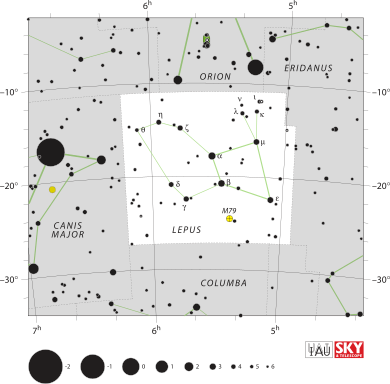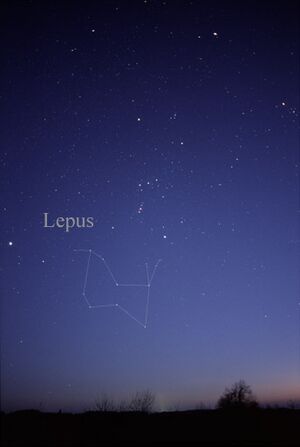Lepus (constellation) facts for kids
| Constellation | |

List of stars in Lepus
|
|
| Abbreviation | Lep |
|---|---|
| Genitive | Leporis |
| Pronunciation | or colloquially genitive |
| Symbolism | the Hare |
| Right ascension | 6 |
| Declination | −20 |
| Quadrant | NQ2 |
| Area | 290 sq. deg. (51st) |
| Main stars | 8 |
| Bayer/Flamsteed stars |
20 |
| Stars with planets | 3 |
| Stars brighter than 3.00m | 2 |
| Stars within 10.00 pc (32.62 ly) | 3 |
| Brightest star | α Lep (Arneb) (2.58m) |
| Messier objects | 1 |
| Meteor showers | None |
| Bordering constellations |
Orion Monoceros Canis Major Columba Caelum Eridanus |
| Visible at latitudes between +63° and −90°. Best visible at 21:00 (9 p.m.) during the month of January. |
|
Lepus is a constellation you can find in the southern part of the sky. Its name comes from Latin and means "the hare". This constellation isn't based on any specific story from Greek mythology.
Lepus was first listed by the astronomer Ptolemy way back in the 2nd century. Today, it's one of the 88 modern constellations we recognize. You can spot it right below the constellation Orion, who is known as the hunter. It looks like a hare being chased by Orion in the night sky!
It's important not to confuse Lepus, the hare, with Lupus, which is a different constellation representing the wolf.
Exploring the Lepus Constellation
The Lepus constellation has some interesting things to see in space. These are called "deep-sky objects" because they are far away from Earth.
Amazing Deep-Sky Objects
- IC 418 is a special type of cloud in space called a planetary nebula. It's about 1,100 light years away from us. A planetary nebula forms when a star like our Sun reaches the end of its life and sheds its outer layers.
- M79 is a globular cluster. Think of it as a giant ball of hundreds of thousands of stars, all packed closely together. M79 is about 42,000 light-years from Earth. It's one of the few globular clusters you can see during the winter in the Northern Hemisphere. It looks like a fuzzy ball through a telescope.
Images for kids
See also
 In Spanish: Lepus (constelación) para niños
In Spanish: Lepus (constelación) para niños




